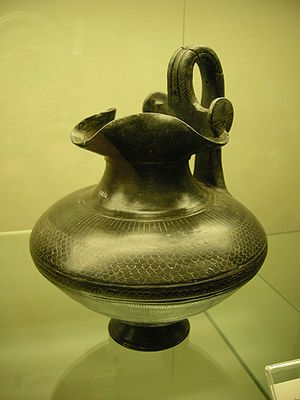- Bucchero
-
Bucchero
Los buccheros (ˈbukkero; voz italiana del portugués- bucáro) fueron un tipo de cerámica negra típica de la civilización etrusca. Se cree que sus primeras obras fueron creadas a principios del siglo VII a. C. en el asentamiento etrusco de Cerveteri.
El método de cocción volvía negra la cerámica y hacía brillar metálicamente las superficies, quemando cuidadosamente las piezas después de cocerlas. Las urnas y las vasijas etruscas hechas con este sistema se parecen bastante a las vasijas griegas, construidas igualmente con materiales locales. No se sabe si hay o no relación con el impasto, la cerámica típica de la cultura de Villanova.
El proceso de fabricación requería unos hornos capaces de soportar temperaturas de 900ºC y 1050ºC.
Etimología
La voz portuguesa bucáro se refería a diversas vasijas de las culturas sudamericanas conquistadas por Portugal. Los italianos tomaron el nombre en el siglo XIX, que la arqueología moderna aplicó a este tipo de cerámica etrusca.
Galería de imágenes
Bibliografía
En inglés:
- Hirschland-Ramage, Nancy (1970). «Studies in Early Etruscan Bucchero» Papers of the British School at Rome. Vol. 38. pp. 1–61.
- Rasmussen, Tom B. (1979). Bucchero pottery from Southern Etruria. Cambridge: Cambridge University Press. ISBN 0-521-22316-4.
- Bouloumié, Bernard: Le bucchero nero d'Etrurie, in: Latomus 41 (1982), bl. 773-784. (Frans)
- Lollini, Delia: Bucchero. In: Enciclopedia dell'arte antica classica e orientale, boekdeel 2, Rome 1959, bl. 203-210. (Italiaans)
- Redaksie Grandi Opere dell'Istituto Geografico DeAgostini: Gli Etruschi e i Romani. Meraviglie dell'Archeologia. Novara: Istituto Geografico DeAgostini S.p.A. 1998 (Italiaans)
- Schneider, Helmuth: Einführung in die antike Technikgeschichte. Darmstadt: Wissenschaftliche Buchgesellschaft 1992
Categoría: Arte etrusco
Wikimedia foundation. 2010.





